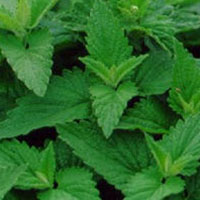Catnip
Uses
Parts Used & Where Grown
Catnip is a whitish-gray plant with a minty odor. The flowers are white with crimson dots. The catnip plant grows in North America and Europe. The leaves and flowers are used as medicine.
Our proprietary “Star-Rating” system was developed to help you easily understand the amount of scientific support behind each supplement in relation to a specific health condition. While there is no way to predict whether a vitamin, mineral, or herb will successfully treat or prevent associated health conditions, our unique ratings tell you how well these supplements are understood by the medical community, and whether studies have found them to be effective for other people.
For over a decade, our team has combed through thousands of research articles published in reputable journals. To help you make educated decisions, and to better understand controversial or confusing supplements, our medical experts have digested the science into these three easy-to-follow ratings. We hope this provides you with a helpful resource to make informed decisions towards your health and well-being.
3 StarsReliable and relatively consistent scientific data showing a substantial health benefit.
2 StarsContradictory, insufficient, or preliminary studies suggesting a health benefit or minimal health benefit.
1 StarFor an herb, supported by traditional use but minimal or no scientific evidence. For a supplement, little scientific support.
This supplement has been used in connection with the following health conditions:
| Used for | Why |
|---|---|
1 Star Cough Refer to label instructions | Catnip has a long history of use for relieving coughs. The mucilage of slippery elm gives it a soothing effect for coughs. Usnea also contains mucilage, which may be helpful in easing irritating coughs. There is a long tradition of using wild cherry syrups to treat coughs. Other traditional remedies to relieve coughs include bloodroot, , comfrey (the above-ground parts, not the root), horehound, elecampane, mullein, lobelia, hyssop, licorice, mallow, (Malvia sylvestris),red clover, ivy leaf, pennyroyal(Hedeoma pulegioides, Mentha pulegium),onion, (Allium cepa), and plantain (Plantago lanceolata, P. major). None of these has been investigated in human trials, so their true efficacy for relieving coughs is unknown. |
1 Star Insomnia Refer to label instructions | Catnip is commonly recommended by doctors as a mild sedative for those suffering from insomnia or nervous exhaustion. Combining valerian root with other mildly sedating herbs is common both in Europe and the United States. Chamomile, hops, passion flower, lemon balm, American scullcap, and are commonly recommended by doctors. These herbs can also be used alone as mild sedatives for those suffering from insomnia or nervous exhaustion. Chamomile is a particularly good choice for younger children whose insomnia may be related to gastrointestinal upset. Hops and lemon balm are approved by the German government for relieving sleep disturbances. |
Traditional Use (May Not Be Supported by Scientific Studies)
Catnip is famous for inducing a delirious, stimulated state in felines. Throughout history, this herb has been used in humans to produce a sedative effect.1 Several other conditions (including cancer, toothache, corns, and hives) have been treated with catnip by traditional herbalists.
How It Works
The volatile oil in catnip contains the monoterpene, nepetalactone, which is similar to the valepotriates found in valerian, a more commonly used herbal sedative.2 Human trials are lacking to prove the effectiveness of catnip for treating insomnia. It has been used traditionally to reduce gas and act as a digestive aid.3
How to Use It
A catnip tea can be made by adding 1 cup (250 ml) of boiling water to 1–2 teaspoons (5–10 grams) of the herb; cover, then steep for ten to fifteen minutes. Drink 2–3 cups per day.4 For children with coughs, 1 teaspoon (5 ml) of tincture three times per day can be used. Adults may take twice this amount.
Interactions with Supplements, Foods, & Other Compounds
Interactions with Medicines
Side Effects
Since catnip (particularly the volatile oil) may act to promote uterine contractions, it should not be used during pregnancy.
1. Tyler VE. Herbs of Choice. Binghamton, NY: Pharmaceutical Products Press, 1994, 120-1.
2. Weiss RF. Herbal Medicine. Gothenburg, Sweden: Ab Arcanum, 1988, 282.
3. Sherry CJ, Hunter PS. The effect of an ethanol extract of catnip (Nepeta cataria) on the behavior of the young chick. Experientia 1979;35:237-8.
4. Gruenwald J, Brendler T, Jaenicke C, et al. (eds). PDR for Herbal Medicines. Montvale, NJ: Medical Economics, 1998, 991-2.
Last Review: 05-28-2015

Copyright © 2024 TraceGains, Inc. All rights reserved.
Learn more about TraceGains, the company.
The information presented by TraceGains is for informational purposes only. It is based on scientific studies (human, animal, or in vitro), clinical experience, or traditional usage as cited in each article. The results reported may not necessarily occur in all individuals. For many of the conditions discussed, treatment with prescription or over the counter medication is also available. Consult your doctor, practitioner, and/or pharmacist for any health problem and before using any supplements or before making any changes in prescribed medications. Information expires December 2024.
This information does not replace the advice of a doctor. Ignite Healthwise, LLC, disclaims any warranty or liability for your use of this information. Your use of this information means that you agree to the Terms of Use. Learn how we develop our content.

